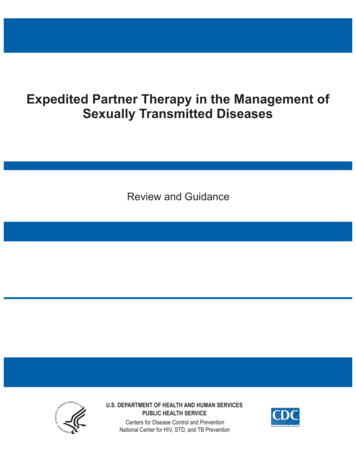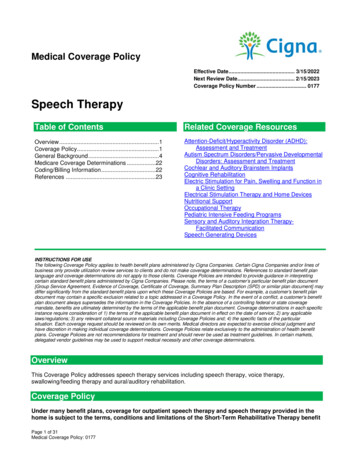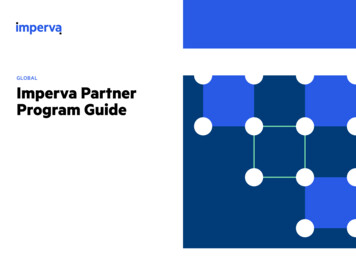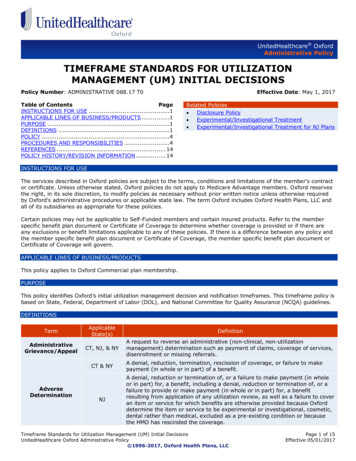
Transcription
Expedited Partner Therapy in the Management ofSexually Transmitted DiseasesReview and GuidanceU.S. DEPARTMENT OF HEALTH AND HUMAN SERVICESPUBLIC HEALTH SERVICECenters for Disease Control and PreventionNational Center for HIV, STD, and TB Prevention
EXPEDITED PARTNER THERAPY IN THE MANAGEMENT OF SEXUALLYTRANSMITTED DISEASESContributors:H. Hunter Handsfield, M.D. 1, 2Matthew Hogben, Ph.D. 1Julia A. Schillinger, M.D., M.Sc. 1Matthew R. Golden, M.D., M.P.H. 2, 3Patricia Kissinger, Ph.D. 4P. Frederick Sparling, M.D. 512Division of STD Prevention, Centers for Disease Control and PreventionDepartment of Medicine and Center for AIDS and STD, University of Washington34Public Health - Seattle & King County STD ProgramTulane University Health Sciences Center, School of Public Health and Tropical Medicine5School of Medicine, University of North Carolina at Chapel HillSuggested Citation:Centers for Disease Control and Prevention. Expedited partner therapy in the managementof sexually transmitted diseases. Atlanta, GA: US Department of Health and HumanServices, 2006.
PREFACEThis report was prepared at the direction of John M. Douglas, Jr., M.D., Director, Divisionof STD Prevention, NCHSTP, CDC. It summarizes the available literature on expeditedpartner therapy (EPT) for the management of the partners of persons with STD andinterprets the results. It also incorporates perspectives gained from two expertconsultations, one that predominantly addressed the scientific evidence related to EPT and asecond that emphasized operational issues that will affect implementation of EPT. Thereport serves as background on EPT and provides the evidence in support of anticipatedguidelines for the selective use of EPT. It is intended as a reference document for use byCDC and by public health agencies, other organizations, interested individuals, and otherpartners in the public and private sector.2
TABLE OF CONTENTSExecutive Summary4Introduction7Current Practices9Research in Expedited Partner Therapy11Implementation ces35Tables and Figures393
EXECUTIVE SUMMARYOverviewExpedited partner therapy (EPT) is the practice of treating the sex partners of persons withsexually transmitted diseases (STD) without an intervening medical evaluation orprofessional prevention counseling. The usual implementation of EPT is through patientdelivered partner therapy (PDPT), although other methods may be employed. The availableliterature and selected unpublished studies were systematically reviewed, and this reportprovides background for the development of guidance on use of EPT as an option forpartner management for selected STDs and patients.EvidenceFor STDs other than syphilis, partner management based on patient referral or providerreferral has had only modest success in assuring partner treatment, largely attributable tolimitations of available financial and personnel resources. EPT is believed to have beenwidely employed in women with trichomoniasis. Recent surveys document occasional useby many primary care providers in the management of patients with gonorrhea andchlamydial infection, and consistent use by a few. A retrospective case control study andtwo process-oriented analyses suggested that EPT holds promise as a partner managementoption. These studies contributed to CDC decisions to fund 4 randomized controlled trials(RCTs) designed to compare EPT with standard partner management approaches in menand women with gonorrhea, chlamydial infection, or trichomoniasis; and to assessbehavioral predictors of treatment and reinfection.Persistent or Recurrent InfectionThe first RCT of EPT followed 1,787 women in 6 cities after treatment for chlamydialinfection. Recurrent infection was documented at follow-up visits 1 months and 4 monthslater in 12% of women randomized to EPT and 15% of those managed by patient referral(odds ratio [OR] 0.80, 95% confidence interval [CI] 0.62-1.05). The second RCT enrolled2,751 men and women with gonorrhea or chlamydial infection from both public and privatecare settings in a single metropolitan area. Persistent or recurrent infection with eitherdisease was found in 9.9% of subjects randomized to EPT and 13.0% of those who hadstandard patient-referral or provider-referral of their partners (OR 0.76, 95% CI 0.59-0.98).EPT was more effective in preventing gonorrhea at follow-up (OR 0.32, 95% CI 0.13-0.77)than chlamydial infection (OR 0.82, 95% CI 0.62-1.07). Chlamydial infection was presentat follow-up in 7.6% of women who denied all sex since treatment, suggesting that a higherthan expected rate of treatment failure accounted for some infections at follow-up. In thethird available RCT, 977 men with symptomatic urethritis (principally gonorrhea andchlamydial infection) were randomized to EPT, patient referral, or patient referral enhancedby written education materials. Follow-up testing for gonorrhea and chlamydial infection4-8 weeks later was accomplished in 37.5% of patients. Persistent or recurrent infectionwas found in 43% of subjects in the patient referral group (referent), 14% of menrandomized to enhanced patient referral (OR 0.22, 95% CI 0.11-0.44, P 0.001), and 23% ofmen randomized to EPT (OR 0.38, 95% CI 0.19-0.74, P 0.001). For trichomoniasis, in anas yet unpublished RCT of 463 women randomized to the same interventions as the male4
urethritis trial, with 80% follow-up, the prevalences of infection 3-7 weeks later were notsignificantly different for patient referral (6%), enhanced patient referral (9%), or EPT(9%).Behavioral OutcomesThe 4 available RCTs evaluated the association of EPT with index cases’ reports of successin partner notification, confidence that their partners were treated, and sexual behaviorslikely to predict reinfection. In 2 trials that enrolled male index cases, men randomized toEPT were equally or more likely to notify their partners than those randomized to thecontrol strategies. Female index cases with chlamydial infection or gonorrhea who wererandomized to EPT had either equivalent success or enhanced success in notifying partnerscompared with women randomized to standard partner management. In all 3 trials ofgonorrhea or chlamydial infection, EPT was associated with at least equivalent andtypically increased confidence by both male and female index cases that their partners hadreceived treatment, including direct observation that their partners took medication. Twotrials that addressed both gonorrhea and chlamydial infection found EPT to be associatedwith significantly reduced rates of sex with untreated partners at follow-up. Thetrichomoniasis trial showed general equivalence of EPT with desirable behavioral outcomescompared with standard patient referral.Cost EffectivenessPreliminary economic analyses suggest that EPT is a cost-saving and cost effective partnermanagement strategy.LimitationsThe data available to support EPT for chlamydial infection were derived in larger andgeographically more diverse samples of patients than those for gonorrhea. Nevertheless,the evidence in favor of EPT, as measured by the rate of persistent or recurrent infection atfollow-up, is stronger for gonorrhea than for chlamydial infection, perhaps due to a higherthan expected rate of persistent chlamydial infection in women. This finding confounds theassessment of EPT in women with chlamydial infection. Assuring the treatment of infectedmen’s female partners is a high priority to prevent ongoing transmission and communityspread.As for all RCTs, the extent to which the results of the available trials can be safelygeneralized to other populations and settings is not certain. Owing to modest sample sizesin some disease-specific patient groups, and varying effect sizes, not all outcomes ofinterest have been shown to be statistically significant. For example, further data aredesirable on the use of EPT in male index cases. The available data do not support theroutine use of EPT in the management of trichomoniasis, and no published data support theuse of EPT for chlamydial infection or gonorrhea in men who have sex with men (MSM).Although substantial numbers of adolescents were included in the available trials, there islittle experience in patients 18 years old.5
Issues in Implementation of EPTAmong several pragmatic issues that will influence implementation of EPT as an STDprevention strategy, a dominant one is the possibility of undetected STD in partners. Thepotential for undiagnosed pelvic inflammatory disease (PID) is of concern when EPT isused to treat the female partners of men with gonorrhea or chlamydial infection. Therefore,EPT intended for female partners should be accompanied by warnings about the symptomsof PID and advice that women seek medical attention in addition to accepting treatment.Undiagnosed gonorrhea and chlamydial infection are common in the partners of womenwith trichomoniasis, and undiagnosed HIV infection and other morbidities have been foundin many partners of STD-infected MSM.The legality of EPT is uncertain in some states and overt statutory impediments exist inothers; the practice is clearly legal only in a few states. The medicolegal ramifications maybe uncertain in the event of adverse outcomes in the recipients of EPT. Other barriersinclude direct and indirect costs, including limitations on third-party insurance coverage;missed opportunities for prevention counseling of partners; risks of allergic reactions andother adverse drug effects; administrative barriers; privacy issues; and the attitudes andbeliefs of health care providers and agencies about the practice.ConclusionsBoth clinical and behavioral outcomes of the available studies indicate that EPT is a usefuloption to facilitate partner management among heterosexual men and women withchlamydial infection or gonorrhea. The evidence indicates that EPT should be available toclinicians as an option for partner management, although ongoing evaluation will be neededto define when and how EPT can be best utilized. EPT represents an additional strategy forpartner management that does not replace other strategies, such as standard patient referralor provider-assisted referral, when available. Along with medication, EPT should beaccompanied by information that advises recipients to seek personal health care in additionto EPT. This is particularly important when EPT is provided to male patients for theirfemale partners, and for male partners with symptoms. Existing data suggest that EPT hasa limited role in partner management for trichomoniasis. No data support its use in theroutine management of syphilis, and there is no experience with EPT for gonorrhea orchlamydial infection among MSM.6
INTRODUCTIONAssuring treatment of infected persons’ sex partners has been a central component ofprevention and control of bacterial STDs in the United States for six decades, since theconcept was introduced in the United States by Thomas Parran and systematic efforts wereimplemented for the prevention of syphilis under Parran’s leadership of the U.S. PublicHealth Service in the 1940s.1 In general, treatment has been recommended for all partnerssexually exposed to the infected index case within a specified time interval in order toprevent morbidity in the partners and curtail transmission. Usually treatment was precededby clinical evaluation, diagnostic testing, and education or formal counseling, andattendance at traditional clinical facilities was required. Initially developed as a strategy forcontrol of syphilis, such partner management came to be widely recommended forgonorrhea, chlamydial infection and, most recently, human immunodeficiency virus (HIV)infection.2,3Several strategies have been employed to facilitate clinical assessment and treatment ofpartners, as indicated in the Centers for Disease Control and Prevention’s ProgramOperations Guidelines.2 With provider referral, partners are directly contacted, usually bytelephone or in person, by the index patient’s health care provider or by a diseaseintervention specialist (DIS) or other outreach worker on behalf of the provider. Underpatient referral, also called self referral, the index patient assumes primary responsibility tonotify and refer his or her partners at risk. These approaches may be combined. Forexample, conditional referral, also called contract referral, describes patient referralsupplemented by provider referral, such as a telephone reminder, for partners who do notrespond within a specified time. The term dual referral also has been used, particularly inthe context of HIV partner management, to describe joint referral by the patient and apublic health professional.3 Patient referral also can be supplemented by variousmechanisms to assist the index patient in notifying his or her partners; for example, cardreferral means providing patients with appointment cards to deliver to partners.Despite extensive use, the contribution of partner management to overall STD preventionand control has been difficult to ascertain. Success has been evaluated largely by analysisof process indicators, such as numbers of partners elicited and the number brought totreatment. By these measures, provider referral strategies generally have been mosteffective.4-6 Provider referral is widely considered to have contributed significantly tocontrol of syphilis, with a 1990s trial providing estimates of process effectiveness,7 but theefficacy of traditional partner management in assuring treatment of the partners of personswith gonorrhea or chlamydial infection remains problematical and their contribution toprevention and control uncertain. Social network approaches for management of thepartners of persons with syphilis or HIV infection have shown substantial promise inretrospective evaluations,8,9 but have not been studied for chlamydial infection, and may betoo costly for routine use in most settings. A single prospective evaluation of networktechniques to enhance interviews and analyze data uncovered more syphilis cases thanwould have resulted from contacting only the sex partners of infected persons.10Most STD cases in the United States are diagnosed and treated in the private sector byprimary care providers,11 but the available data on partner management are dominated byanalyses in patients attending STD clinics or other public health clinics who often may not7
be representative of most infected persons. Except for syphilis, most health departmentsmake little direct effort in partner management for persons with STDs treated in the privatesector.12,13 The Institute of Medicine described STD partner management in the UnitedStates as inadequate, inefficient, and in need of redesign.14Anecdotal reports have long suggested that some clinicians selectively arrange fortreatment of partners without referral or examination, typically by providing the indexpatient medication for his or her partner(s) or by writing a prescription to be delivered bythe patient to the partner. This practice is generally believed to have been particularlywidely used for the treatment of the male partners of women with vaginal trichomoniasis.*Nevertheless, public health and prevention experts have typically insisted that treatment forpartners of persons with gonorrhea, chlamydial infection or syphilis be administered onlythrough direct clinical intervention. However, as the inadequacy of resources for providerreferral and the modest success rate of patient referral in assuring notification and treatmentof partners became apparent, streamlined approaches to partner management became thesubject of increasing attention.This document reviews the evidence for use of expedited partner therapy (EPT), defined astreatment of partners without an intervening personal assessment by a health care provider.EPT may be implemented by any of several methods. The usual method in many settings,and the one used predominantly to date, is patient-delivered partner therapy (PDPT),wherein clinicians provide their patients with drugs intended for the partners, prescribeextra doses of medication in the index patients’ names, or write prescriptions in thepartners’ names. Other potential means to achieve EPT include non-prescriptivearrangements with cooperating pharmacies, retrieval of medication by partners at publichealth clinics or other venues, or delivery of medication to partners in non-clinical settingsby public health workers.*There are several possible reasons that the practice gained currency for trichomoniasis in particular.For many years trichomoniasis probably was not widely understood by many clinicians to be anSTD, despite the conflict of that perception with the practice itself. Until the 1980s, gonorrheatypically required penicillin by injection and chlamydial infection was virtually unknown, so thattrichomoniasis was the only commonly diagnosed STD that could be managed with single doses orshort courses of oral antibiotic. Further, some clinicians may have believed that local or state healthdepartments would assure treatment of the partners of patients with reportable STDs, but nottrichomoniasis.8
CURRENT PRACTICESTraditional Partner ManagementTo estimate the scope of attempted provider referral for common STDs by public healthdepartments, Golden et al. surveyed 78 metropolitan health departments that collectivelyrepresented the 50 cities in the United States with the highest rates of at least one reportablebacterial STD (gonorrhea, chlamydial infection, syphilis) and the 50 metropolitan areaswith the highest reported rates of AIDS.12,13 Sixty health departments (77%) submittedusable responses. Of 8,492 cases of infectious syphilis reported to these healthdepartments, in 7,583 cases (89%) public health authorities attempted to assure treatment ofthe patients’ sex partners. By contrast, the responding health departments attempted toidentify and contact the partners of 17% of 139,287 reported cases of gonorrhea and 12% of228,210 persons with chlamydial infection. When partner management was attempted forpersons with gonorrhea or chlamydial infection, patient referral was the predominant modelemployed. Forty-one health departments (68%) made no attempt to notify or contact thepartners of patients treated for gonorrhea outside public health clinics, and 46 (77%) madeno such attempt for the partners of persons with chlamydial infection. The surveyrespondents cited lack of sufficient personnel and other resources as the dominant reasonfor low partner management coverage.12Most health care providers advise their patients with STD to notify their sex partners. St.Lawrence et al. reported on the practices of a national probability sample of 4,223physicians in 5 specialties that report most STD morbidity in the United States (general orfamily practice, internal medicine, pediatrics, gynecology-obstetrics, emergencymedicine).15 Eighty-eight percent of the respondents were in private practice and thesurvey had a 70% response rate. Almost 82% of respondents reported that they advisedtheir infected patients to notify partners of exposure to gonorrhea or chlamydial infectionand 9-11% collected partner information to send to a health department; only 4% attemptedprovider referral. In another analysis of the same national probability sample, Hogben etal.16 found that most physicians in the U.S. were willing to report STD cases to their localhealth departments, but most respondents believed that provider referral is no more usefulthan patient referral in assuring partner treatment and were less supportive of providerreferral by health departments than of other partner management strategies. Among 150private sector providers in King County, Washington who had reported 1 case ofchlamydial infection in the preceding year, 135 (90%) said they told their patients that theirsex partners required treatment, and 72 (95%) of 76 patients acknowledged that they hadbeen so informed.17 Twenty-six providers (17%) were confident that all partners at risk hadbeen treated.Thus, patient referral is the dominant mechanism employed in the U.S. to assure treatmentof the partners of persons with chlamydial infection or gonorrhea. The proportion ofpartners who actually receive treatment or other direct clinical services is difficult toascertain. Table 1 summarizes the results of 7 studies conducted in the United States andwestern Europe that reported the success of various patient referral strategies conducted bypublic health personnel to achieve treatment of partners exposed to gonorrhea or chlamydialinfection.18-24 One study reported that 29% of partners were successfully treated; the9
remaining studies reported success rates from 49% to 59%. The proportion of partners whorespond to patient referral as practiced by most providers, without the involvement ofpublic health personnel, is unknown. However, the available data suggest that roughly halfof all partners of persons with gonorrhea or chlamydial infection receive treatment.Expedited Partner TherapyEmerging data indicate that many providers in the United States selectively employ EPT forgonorrhea and chlamydial infection and that some do so routinely. Hogben et al.25 analyzedthe responses of the national sample of physicians described above15 to questions about theproviders’ partner management practices (Figure 1). Among 2,538 physicians whoreported treating at least one patient for chlamydial infection in the preceding 12 months,56% had managed at least one partner by PDPT and 15% “usually” or “always” did so.The results were similar for gonorrhea, with 50% of providers reporting use of PDPT and11% reporting PDPT as their usual or universal approach to partner management. Theinvestigators estimated that PDPT had been employed in the management of 9% to 15% ofthe respondents’ patients with gonorrhea and 13% to 20% of those with chlamydialinfection.Four geographically limited surveys also have addressed the practice of EPT. Among 111Connecticut and Rhode Island physicians, 48% indicated favorable attitudes toward PDPT,50% had employed the practice, and 6% reported using PDPT “frequently”.26 Of 150providers surveyed in King County, Washington, 57% had employed EPT for chlamydialinfection in the preceding year and 21% reported doing so at least half the time, althoughonly 5% of the providers had done so for their most recently diagnosed cases.17 In astratified random sample of 708 physicians and 805 nurse practitioners in Californiaundertaken soon after legislation was adopted to legalize EPT for chlamydial infection,EPT was reported substantially more frequently than in the preceding studies; about half therespondents reported “usually” or “always” using EPT for their patients with chlamydialinfection, primarily by providing index patients with prescriptions for their partners.27Finally, according to preliminary analysis of a survey of providers in New York City,28approximately half the respondents had ever used PDPT and 27% reported doing so“frequently.” In the New York survey, an atypically high proportion of providers (24%)reported that they directly contacted their patients’ partners (provider referral).28Collectively, the national survey and two of the regional ones suggest that roughly half ofU.S. clinicians who treat STD cases use EPT selectively and that 5% to 10% do sofrequently or as their standard approach to partner management. EPT may be used morefrequently in California than elsewhere, perhaps because the survey was conducted amidpublicity about recent legalization of the practice for chlamydial infection. New York Cityproviders apparently use EPT more frequently than in most regions but less frequently thanthose in California.10
RESEARCH IN EXPEDITED PARTNER THERAPYPreliminary StudiesThe first published study with data on EPT was a retrospective analysis of the prevalence ofChlamydia trachomatis within 12 weeks of treatment for chlamydial infection in Swedishwomen (Figure 2).29 Among 372 women in whom no effort was made to identify or treatpartners, 38 (10.2%) had recurrent or persistent infection. Infection was present in 84(8.4%) of 997 women told to refer their partners without further follow-up (patient referral),and in 31 (4.5%) of 645 women who were told to refer partners followed by reminderswhen partners failed to appear (conditional referral). Among 167 women managed withPDPT, 3 (1.8%) had persistent or recurrent infection. Although the partner managementstrategies were not randomly assigned and provider selection probably influenced theresults, this report offered the first evidence that EPT might hold promise for partnermanagement in women with chlamydial infection.Kissinger et al. analyzed reinfection rates in 256 women with chlamydial infection treatedat an urban STD clinic, of whom 178 were re-tested a mean of 17.7 7.7 months later.30The annualized rate of reinfection was 12% among 43 women managed with PDPT,compared with 22% of 135 managed by card-enhanced patient referral (odds ratio [OR]0.37, 95% confidence interval [CI] 0.15-0.97, P 0.05). In Uganda, Nuwaha et al.undertook a randomized controlled trial (RCT) of PDPT compared with card-enhancedpatient referral in STD clinic patients given syndromic management for urethral or vaginaldischarge.31 After 2 weeks follow-up, index patients managed with PDPT reported that 176(74%) of 237 identified partners had received treatment, whereas 79 (34%) of the 234partners identified by control patients attended the clinic to be treated. Although theinvestigators reported these outcomes as significant in favor of PDPT (OR 2.44, 95% CI1.95-3.07), the differences in ascertainment of partner therapy—index case report vs.partner attendance at a clinic—make comparison difficult and the validity of the outcomeuncertain.Randomized Controlled Trials: Biomedical OutcomesFour RCTs comparing EPT with traditional partner referral strategies, funded wholly or inpart by CDC, have been conducted in the United States among patients with gonorrhea,chlamydial infection or trichomoniasis.32-35 The prevalences of persistent or recurrentinfection in index cases at follow-up are summarized in Table 2.Multicenter Study of Chlamydial Infection in WomenSchillinger et al.32 conducted a trial of PDPT compared with patient referral in women withuncomplicated chlamydial infection from 1996 to 2000 in 6 metropolitan areas, includingSan Francisco, California; Seattle, Washington; New Orleans, Louisiana; Birmingham,Alabama; Indianapolis, Indiana; and urban southern California (Long Beach, Torrance andLos Angeles). Patients were diagnosed in family planning, teen health, primary care, andSTD clinics, and emergency departments. Initial chlamydial infections were diagnosed byvarious tests in routine use at the participating clinics, and follow-up infections were11
determined by nucleic acid amplification tests (NAAT) (specifically, ligase chain reaction[LCR] or polymerase chain reaction [PCR]) testing of urine specimens. A total of 1,787eligible subjects were randomly assigned either to partner management by PDPT withsingle doses of 1.0 g azithromycin (for up to 4 partners) or to patient referral. In bothgroups the subjects were counseled to tell their partners about exposure and to encouragethe partners to seek treatment. Those in the PDPT arm were provided with packets fordelivery to their partners that contained powdered azithromycin, instructions on drugreconstitution and administration, advice about possible adverse effects and to abstain fromsexual intercourse until 7 days after treatment, and a fact sheet about chlamydial infection.Control subjects, but not those in the PDPT arm, were provided with a list of clinics wheretheir partners could obtain cost-free care.Follow-up visits were scheduled 1 month and 4 months after enrollment. At least 1 followup visit was completed 3 weeks after treatment in 728 (82%) of 887 patients assigned toPDPT and 726 (81%) of 900 controls.32 The control and intervention groups were similardemographically and in several behavioral measures. Women found to be infected at thefirst follow-up visit were not followed thereafter. At the first follow-up visit, C.trachomatis was identified in 37 women (5.1%) in the PDPT group and 54 (7.4%) of thosein the patient referral arm. Among women who were chlamydia-negative at the firstfollow-up and were followed again a median of 13 weeks after treatment, C. trachomatiswas identified in 50 (11.1%) of 450 women in the PDPT arm and 54 (12.2%) of 443controls. Thus, the cumulative prevalences of persistent or recurrent infection were 87(12.0%) of women in the PDPT arm and 108 (14.9%) of controls (OR 0.80, 95% CI 0.621.05, P 0.102). (The analysis assumed that women who tested negative at 1 month andwere not followed further remained uninfected.) This effect remained after adjusting forpatient age and study center, and the risk of reinfection was not correlated with compliancewith the intervention within each study arm. Among women who reported a new sexpartner after treatment and before follow-up, those the PDPT arm were more likely to bereinfected than women in the patient referral arm.Gonorrhea and Chlamydial Infection in Men and Women, King County, WashingtonFrom 1998 to 2003, Golden et al.33 contacted 7,723 patients with reported gonorrhea orchlamydial infection (among 26,656 reported cases). After excluding 2,471 persons whodeclined study participation and 2,501 who believed all partners at risk had already beentreated, the investigators randomized 2,751 subjects to EPT (N 1,376) or standard partnermanagement (N 1,375). Nineteen percent of enrolled subjects were diagnosed in publicSTD clinics, 23% in other public health clinics, 13% in community or family planningclinics, 12% in hospital emergency departments, and 33% by other clinicians in the privatesector. Statistically significant differences between participants and th
Expedited partner therapy (EPT) is the practice of treating the sex partners of persons with sexually transmitted diseases (STD) without an intervening medical evaluation or professional prevention counseling. The usual implementation of EPT is through patient-delivered partner therapy (PDPT), although other methods may be employed. The available










